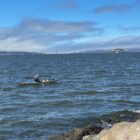With few visible signs, effects of pollution may be long-lasting underwater
A community-funded report originally published on Spot.us
By Aaron Crowe
A"dirty bathtub ring" and a some oil under a few rocks are about all that remain from the Cosco Busan oil spill more than a year ago in the San Francisco Bay.
The spill of nearly 54,000 gallons of heavy fuel when the container ship hit the San Francisco Oakland Bay Bridge on the foggy morning of Nov. 7, 2007, was the largest spill in the bay in 20 years. It killed nearly 3,000 birds, fouled 69 miles of beaches and spurred hundreds of volunteers to help with the cleanup around the bay. Cleanup and compensation costs are estimated at $90 million.
While officials can’t guarantee that another another such accident won’t happen again, they say that many measures have been taken to try to prevent it.
"The vessel would have never left the dock" if new marine safety rules that have since been adopted were in place, said Coast Guard Capt. Paul Gugg, who oversees the San Francisco area. New rules ban large ships leaving port or sailing near bridges in less than a half-mile of visibility. In the Cosco Busan accident, the man in charge of navigating the ship, Capt. John Cota, was piloting in thick fog with visibility of less than a quarter of a mile, and tried to take evasive action while near the bridge. But it sideswiped the tower, ripping a hole in the left side of the ship.
Soon after the accident, Cota said in a recording on the ship, "So yeah, it’s foggy … I shouldn’t have gone. I’m not going to do well on this one." A report by the state Board of Pilot Commissioners in January found seven serious errors in Cota’s piloting of the ship and concluded that "pilot misconduct was a factor" in the accident.
Cota, 60, of Petaluma, has pleaded innocent in federal court in San Francisco to charges of not reporting his sleep apnea medication as required to Coast Guard officials during his annual license renewals in 2006 and 2007, and to violating the Clean Water Act and the Migratory Bird Treaty Act. He could be jailed and fined if convicted.
Besides lowering the fog limit, other preventive measures taken since then, Gugg said, include:
- Pre-identifying a command post.
- Plans for better communication early in the disaster.
- Finding more ways for volunteers to help.
In the past year, the Coast Guard has had three exercises on different ways to divert and capture oil, and are now making allowances for the tide, Gugg said. Last year, booms intended to stop the oil slick from moving broke three times because of the strong tide and because the booms were placed in a straight line, he said. Allowances are now being made for the tide, he said.
Gugg also said that after the spill, notification to authorities was slow; in fact, initial reports made the spill sound smaller than it was early in the day. Now the plan is to send a marine inspector out who is knowledgeable about ships to make an assessment, Gugg said. There were also liability problems with cleanup volunteers, and California Gov. Arnold Schwarzenegger has signed a bill in the fall making it easier for volunteers to help clean up oiled beaches.
Still, the cleanup went well, with 43 percent recovered, compared to 10 to 15 percent normally recovered, the Coast Guard captain said.
While oil can’t be seen on top of the water, scientists are studying the long-term effects underwater, and some areas of the bay still have rocks with oil underneath.
"If you look, you can find oil. It’s really not too hard to look," said Chris Reddy, director of the Coastal Ocean Institute in Massachusetts, whose group has been working on the chemistry of the spill since the first week and collecting oil samples.
The oil floated and was easier to pick up than a diesel fuel spill, which could have mixed into the water and been worse for wildlife, Reddy said. On land, the oil left under some rocks is the consistency of tar used to reroof homes, he said.
"The long-term effect is the longer that oil is out there, it becomes like tar on the road," said Reddy, who has seen a "bathtub stain" or "dirty tea stain" at areas east of the Golden Gate Bridge that could be there "a long, long time."
Data is still being collected, but most of the damage in the bay is at pre-spill levels, said Steve Edinger, administrator of the California Fish and Game Office of Spill and Prevention and Response. "Mother Nature does have a way of taking care of it herself," Edinger said.
There are no health warnings as a result of the spill, meaning the bay is as safe as it ever was to swim in. At the Dolphin Club near Ghirardelli Square in San Francisco, members were swimming in the bay three weeks after the spill, although a member who didn’t want to be identified said he swam a mile in the bay the night of the spill and saw and smelled a faint oil sheen. "There’s absolutely no signs of it now," he said of swimming in the bay, although he has noticed fewer birds and some oily rocks that are only noticeable if turned over.
About 3,000 birds were found dead or oiled. Of the 1,068 birds captured alive, 418 were released, which is a 38.5 percent release rate for the Oil Wildlife Care Network. The group typically saves half to 75 percent of birds gathered from a spill.
The ship’s owner, Regal Stone Ltd. of Hong Kong, will be billed for the damage. State Fish and Game Department officials plan on having a dollar figure of the damage in the spring after all of the data is collected, Edinger said.
Finally, the potential loss of herring in the bay from the oil spill is being studied. High levels of mortality and deformities were found in the spawned herring eggs that had been directly oiled, Patrick Rutten, southwest supervisor of the National Oceanic and Atmospheric Administration Restoration Center in Santa Rosa told the San Francisco Chronicle in a story published in November. If the herring population drops in the bay, it’s a wider ecological loss to birds, marine mammals and other fish that feed on them, Rutten said.
Edinger, of the Fish and Game Department, said the herring data isn’t in yet but that herring are in a historic decline and last year’s numbers were high.









